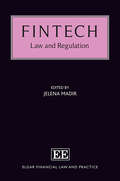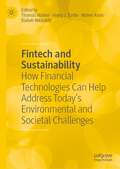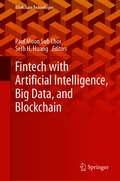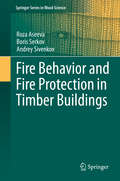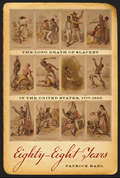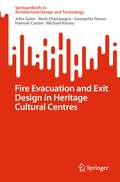- Table View
- List View
Finnie's Notes on Fracture Mechanics: Fundamental and Practical Lessons
by C. K. Dharan B. S. Kang Iain FinnieThis textbook consists primarily of notes by Iain Finnie who taught a popular course on fracture mechanics at the University of California at Berkeley. It presents a comprehensive and detailed exposition of fracture, the fundamentals of fracture mechanics and procedures for the safe design of engineering components made from metal alloys, brittle materials like glasses and ceramics, and composites. Interesting and practical problems are listed at the end of most chapters to give the student practice in applying the theory. A solutions manual is provided to the instructor. The text presents a unified perspective of fracture with a strong fundamental foundation and practical applications. In addition to its role as a text, this reference would be invaluable for the practicing engineer who is involved in the design and evaluation of components that are fracture critical.This book also:Presents details of derivations of the basic equations of fracture mechanics and the historical context of the development of fracture theory and methodologyTreats linear and nonlinear fracture mechanics methodologies beginning with a review of the basic equations of solid mechanics followed by solutions useful in fracture predictionIllustrates the basis of linear elastic fracture mechanics (LEFM), practical applications of LEFM in the design of fracture-tolerant structural componentsOffers interesting, practical, classroom proven problems at the end of most chaptersIncludes instructor's solutions manual
FinTech: Law and Regulation (Elgar Financial Law and Practice series)
by Jelena MadirFinTech has developed rapidly in recent years, and with these developments new challenges arise, particularly for regulators: how do you apply current law to these ever-changing concepts in a world of continual technological advancement? Key features include: • Insight from FinTech specialists from 10 countries, unpicking the legal and regulatory issues across banking, payments and fundraising • Detailed clarification on developments in alternative funding platforms, cryptoassets, initial coin offerings, blockchain and smart contracts • Discussion of innovative solutions for regulators including how to combat the challenges of patenting FinTech inventions and regulating robo-advisors • Guidance for law firms on meeting the challenges presented by the speed of technological innovation and new entrants in the financial sector. Offering a thorough overview of the sector for practical use, FinTech: Law and Regulation will be an invaluable guide for in-house lawyers as well as law firms looking for an overview of legal and regulatory issues in FinTech. It will also be an essential text for those looking to understand the breadth of the sector, as well as the key legal and regulatory issues.
Fintech and Sustainability: How Financial Technologies Can Help Address Today’s Environmental and Societal Challenges
by Thomas Walker Harry Turtle Maher Kooli Elaheh NikbakhtFintech can improve sustainability, influence policies, and require new regulations. Climate change, water pollution, and non-renewable resources management can all be addressed with fintech innovations. Despite the advantages offered by fintech, opponents warn of potential negative consequences. The application of fintech in sustainability is a double-edged sword requiring further investigation. This book provides an overview of fintech applications and considers their impact on the future of sustainable finance. It explores how financial technologies can enhance the sustainability of investment and corporate decisions and contribute to the fulfillment of the Sustainable Development Goals (SDGs). By considering practitioner and academic views, it examines whether and how fintech can improve sustainable practices, potential threats with possible solutions, and policies and regulations designed to improve sustainability benefits.
Fintech with Artificial Intelligence, Big Data, and Blockchain (Blockchain Technologies)
by Paul Moon Sub Choi Seth H. HuangThis book introduces readers to recent advancements in financial technologies. The contents cover some of the state-of-the-art fields in financial technology, practice, and research associated with artificial intelligence, big data, and blockchain—all of which are transforming the nature of how products and services are designed and delivered, making less adaptable institutions fast become obsolete. The book provides the fundamental framework, research insights, and empirical evidence in the efficacy of these new technologies, employing practical and academic approaches to help professionals and academics reach innovative solutions and grow competitive strengths.
Fire and Cellular Polymers
by J. M. Buist S. J. Grayson W. D. WoolleyThis conference, organised jointly by QMC Wolfson Fire & Materials Centre (Queen Mary College) and the Fire Research Station, held at the Tara Hotel in London, UK, was well attended by a wide range of experts in the production and use of polymer foams. Other experts concerned with research, development, testing, specifying, approving and purchasing products incorporating polymer foams for use in the construction, engineering and furniture industries were also present and contributed to the several valuable discussions on specific topics. The conference was successful and achieved its aim of infonning delegates of the fire characteristics of these materials and how they can be assessed in the light of the latest knowledge and technology. The papers presented a wide-ranging review of the main important cellular polymers and their applications in different environments where fire hazards have been encountered. Delegates accepted that there was a continuing need for major growth in the use of cellular polymers and therefore intensified research into development of improved test procedures, fire retardants and smoke suppressants was required.
Fire and Climatic Change in Temperate Ecosystems of the Western Americas (Ecological Studies #160)
by Thomas T. Veblen William L. Baker Gloria Montenegro Thomas W. SwetnamBoth fire and climatic variability have monumental impacts on the dynamics of temperate ecosystems. These impacts can sometimes be extreme or devastating as seen in recent El Nino/La Nina cycles and in uncontrolled fire occurrences. This volume brings together research conducted in western North and South America, areas of a great deal of collaborative work on the influence of people and climate change on fire regimes. In order to give perspective to patterns of change over time, it emphasizes the integration of paleoecological studies with studies of modern ecosystems. Data from a range of spatial scales, from individual plants to communities and ecosystems to landscape and regional levels, are included. Contributions come from fire ecology, paleoecology, biogeography, paleoclimatology, landscape and ecosystem ecology, ecological modeling, forest management, plant community ecology and plant morphology. The book gives a synthetic overview of methods, data and simulation models for evaluating fire regime processes in forests, shrublands and woodlands and assembles case studies of fire, climate and land use histories. The unique approach of this book gives researchers the benefits of a north-south comparison as well as the integration of paleoecological histories, current ecosystem dynamics and modeling of future changes.
The Fire Ant Wars: Nature, Science, and Public Policy in Twentieth-Century America
by Joshua Blu BuhsSometime in the first half of the twentieth century, a coterie of fire ants came ashore from South American ships docked in Mobile, Alabama. Fanning out across the region, the fire ants invaded the South, damaging crops, harassing game animals, and hindering harvesting methods. Responding to a collective call from southerners to eliminate these invasive pests, the U.S. Department of Agriculture developed a campaign that not only failed to eradicate the fire ants but left a wake of dead wildlife, sickened cattle, and public protest. With political intrigue, environmental tragedy, and such figures as Rachel Carson and E. O. Wilson, The Fire Ant Wars is a grippingly perceptive tale of changing social attitudes and scientific practices. Tracing the political and scientific eradication campaigns, Joshua Buhs's bracing study uses the saga as a means to consider twentieth-century American concepts of nature and environmental stewardship. In telling the story, Buhs explores how human concepts of nature evolve and how these ideas affect the natural and social worlds. Spotlighting a particular issue to discuss larger questions of science, public perceptions, and public policy—from pre-environmental awareness to the activist years of the early environmental movement—The Fire Ant Wars will appeal to historians of science, environmentalists, and biologists alike.
The Fire Ant Wars: Nature, Science, and Public Policy in Twentieth-Century America
by Joshua Blu BuhsSometime in the first half of the twentieth century, a coterie of fire ants came ashore from South American ships docked in Mobile, Alabama. Fanning out across the region, the fire ants invaded the South, damaging crops, harassing game animals, and hindering harvesting methods. Responding to a collective call from southerners to eliminate these invasive pests, the U.S. Department of Agriculture developed a campaign that not only failed to eradicate the fire ants but left a wake of dead wildlife, sickened cattle, and public protest. With political intrigue, environmental tragedy, and such figures as Rachel Carson and E. O. Wilson, The Fire Ant Wars is a grippingly perceptive tale of changing social attitudes and scientific practices. Tracing the political and scientific eradication campaigns, Joshua Buhs's bracing study uses the saga as a means to consider twentieth-century American concepts of nature and environmental stewardship. In telling the story, Buhs explores how human concepts of nature evolve and how these ideas affect the natural and social worlds. Spotlighting a particular issue to discuss larger questions of science, public perceptions, and public policy—from pre-environmental awareness to the activist years of the early environmental movement—The Fire Ant Wars will appeal to historians of science, environmentalists, and biologists alike.
The Fire Ant Wars: Nature, Science, and Public Policy in Twentieth-Century America
by Joshua Blu BuhsSometime in the first half of the twentieth century, a coterie of fire ants came ashore from South American ships docked in Mobile, Alabama. Fanning out across the region, the fire ants invaded the South, damaging crops, harassing game animals, and hindering harvesting methods. Responding to a collective call from southerners to eliminate these invasive pests, the U.S. Department of Agriculture developed a campaign that not only failed to eradicate the fire ants but left a wake of dead wildlife, sickened cattle, and public protest. With political intrigue, environmental tragedy, and such figures as Rachel Carson and E. O. Wilson, The Fire Ant Wars is a grippingly perceptive tale of changing social attitudes and scientific practices. Tracing the political and scientific eradication campaigns, Joshua Buhs's bracing study uses the saga as a means to consider twentieth-century American concepts of nature and environmental stewardship. In telling the story, Buhs explores how human concepts of nature evolve and how these ideas affect the natural and social worlds. Spotlighting a particular issue to discuss larger questions of science, public perceptions, and public policy—from pre-environmental awareness to the activist years of the early environmental movement—The Fire Ant Wars will appeal to historians of science, environmentalists, and biologists alike.
Fire Behavior and Fire Protection in Timber Buildings (Springer Series in Wood Science)
by Roza Aseeva Boris Serkov Andrey SivenkovThis volume describes fire behavior and fire protection of timbers in outdoors and indoors application mainly in construction industry. The Authors’ novel approach considers the relationship between various species and age of timbers and its fire behavior at different thermal and fire loads. Quantitative data of ignition speed and flame propagation as well as generation of heat, smoke and toxic products are discussed. Analysis of fire resistance of various types of building materials based on timber of different species as well as the novel data on the effect of natural and accelerated aging of timbers on its fire behavior are discussed. The main practical methods of fire protection of new and ancient timber buildings and structures to increase its fire resistance are considered. The book should be useful for a wide range of readers: chemists, physicists, material scientists, architects, engineers, constructors and restorers.
Fire, Climate Change, and Carbon Cycling in the Boreal Forest (Ecological Studies #138)
by Eric S. Kasischke Brian J. StocksA discussion of the direct and indirect mechanisms by which fire and climate interact to influence carbon cycling in North American boreal forests. The first section summarizes the information needed to understand and manage fires' effects on the ecology of boreal forests and its influence on global climate change issues. Following chapters discuss in detail the role of fire in the ecology of boreal forests, present data sets on fire and the distribution of carbon, and treat the use of satellite imagery in monitoring these regions as well as approaches to modeling the relevant processes.
Fire Design of Steel Structures: EC1: Actions on structures; Part 1-2: Actions on structure exposed to fire; EC3: Design of steel structures; Part 1-2: Structural fire design
by Jean-Marc Franssen Paulo Vila RealThis book explains and illustrates the rules that are given in the Eurocodes for designing steel structures subjected to fire. After the first introductory chapter, Chapter 2 explains how to calculate the mechanical actions (loads) in the fire situation based on the information given in EN 1990 and EN 1991. Chapter 3 is dedicated to the models which represent the thermal actions created by the fire. Chapter 4 describes the procedures to be used to calculate the temperature of the steelwork from the temperature of the compartment and Chapter 5 shows how the information given in EN 1993-1-2 is used to determine the load bearing capacity of the steel structure. Chapter 6 presents the essential features that characterize the advanced calculation models, for thermal and mechanical response. The methods used to evaluate the fire resistance of bolted and welded connections are described in Chapter 7. Chapter 8 describes a computer program called `Elefir-EN? which is based on the simple calculation model given in the Eurocode and allows designers to quickly and accurately calculate the performance of steel components in the fire situation. Chapter 9 looks at the issues that a designer may be faced with when assessing the fire resistance of a complete building. This is done via a case study and addresses most of the concepts presented in the previous chapters. For this second edition the content has been revised and extended. The book contains some new sections, e.g. a comparison between the simple and the advanced calculation, as well as additional examples.
Fire Design of Steel Structures: EC1: Actions on structures; Part 1-2: Actions on structure exposed to fire; EC3: Design of steel structures; Part 1-2: Structural fire design
by Jean-Marc Franssen Paulo Vila RealThis book explains and illustrates the rules that are given in the Eurocodes for designing steel structures subjected to fire. After the first introductory chapter, Chapter 2 explains how to calculate the mechanical actions (loads) in the fire situation based on the information given in EN 1990 and EN 1991. Chapter 3 is dedicated to the models which represent the thermal actions created by the fire. Chapter 4 describes the procedures to be used to calculate the temperature of the steelwork from the temperature of the compartment and Chapter 5 shows how the information given in EN 1993-1-2 is used to determine the load bearing capacity of the steel structure. Chapter 6 presents the essential features that characterize the advanced calculation models, for thermal and mechanical response. The methods used to evaluate the fire resistance of bolted and welded connections are described in Chapter 7. Chapter 8 describes a computer program called `Elefir-EN? which is based on the simple calculation model given in the Eurocode and allows designers to quickly and accurately calculate the performance of steel components in the fire situation. Chapter 9 looks at the issues that a designer may be faced with when assessing the fire resistance of a complete building. This is done via a case study and addresses most of the concepts presented in the previous chapters. For this second edition the content has been revised and extended. The book contains some new sections, e.g. a comparison between the simple and the advanced calculation, as well as additional examples.
Fire Detection in Warehouse Facilities (SpringerBriefs in Fire)
by Joshua Dinaburg Daniel T. GottukAutomatic sprinklers systems are the primary fire protection system in warehouse and storage facilities. The effectiveness of this strategy has come into question due to the challenges presented by modern warehouse facilities, including increased storage heights and areas, automated storage retrieval systems (ASRS), limitations on water supplies, and changes in firefighting strategies. The application of fire detection devices used to provide early warning and notification of incipient warehouse fire events is being considered as a component of modern warehouse fire protection. Fire Detection in Warehouse Facilities provides technical information to aid in the development of guidelines and standards for the use of fire detection technologies for modern warehouse fire protection. The authors share their thorough literature review, analyze characteristic fire hazards for modern warehouse facilities, and identify information gaps in the field. The book concludes with recommendations for the development of guidelines and standards for the use of detection technologies in warehouse fire protection design, including a research plan for implementation. This book is intended for practitioners seeking an understanding of the issues surrounding warehouse design and fire protection. The book will also prove valuable for fire hazard researchers and those involved with fire department response, applicable detection systems, and fire growth suppression.
Fire Ecology and Management: Past, Present, and Future of US Forested Ecosystems (Managing Forest Ecosystems #39)
by Cathryn H. Greenberg Beverly CollinsThis edited volume presents original scientific research and knowledge synthesis covering the past, present, and potential future fire ecology of major US forest types, with implications for forest management in a changing climate. The editors and authors highlight broad patterns among ecoregions and forest types, as well as detailed information for individual ecoregions, for fire frequencies and severities, fire effects on tree mortality and regeneration, and levels of fire-dependency by plant and animal communities. The foreword addresses emerging ecological and fire management challenges for forests, in relation to sustainable development goals as highlighted in recent government reports. An introductory chapter highlights patterns of variation in frequencies, severities, scales, and spatial patterns of fire across ecoregions and among forested ecosystems across the US in relation to climate, fuels, topography and soils, ignition sources (lightning or anthropogenic), and vegetation. Separate chapters by respected experts delve into the fire ecology of major forest types within US ecoregions, with a focus on the level of plant and animal fire-dependency, and the role of fire in maintaining forest composition and structure. The regional chapters also include discussion of historic natural (lightning-ignited) and anthropogenic (Native American; settlers) fire regimes, current fire regimes as influenced by recent decades of fire suppression and land use history, and fire management in relation to ecosystem integrity and restoration, wildfire threat, and climate change. The summary chapter combines the major points of each chapter, in a synthesis of US-wide fire ecology and forest management into the future.This book provides current, organized, readily accessible information for the conservation community, land managers, scientists, students and educators, and others interested in how fire behavior and effects on structure and composition differ among ecoregions and forest types, and what that means for forest management today and in the future.
Fire Engineering and Emergency Planning: Research and applications
by R. BarhamProtection against fire and prevention of explosion is vital in a modern industrial economy. This published proceedings of the First European Conference on Fire Engineering and Emergency Planning provides an authoritative base of materials covering the latest research, applications and hypotheses as a cumulative reference work and a platform for exchanges of ideas within the academic fire community.
Fire Engineering and Emergency Planning: Research and applications
by R. BarhamProtection against fire and prevention of explosion is vital in a modern industrial economy. This published proceedings of the First European Conference on Fire Engineering and Emergency Planning provides an authoritative base of materials covering the latest research, applications and hypotheses as a cumulative reference work and a platform for exchanges of ideas within the academic fire community.
Fire Engines (Shire Library)
by Eddie BakerMore complex and imposing than any other vehicle in the British emergency services, the fire engine has a long and interesting history. The earliest water pumps had been developed by the eighteenth century – basic manual pumps that had to be hauled around by people or horses, and were often only used on fire-insured premises. In the nineteenth and twentieth centuries horse-drawn, steam-powered fire engines, and eventually motorised fire engines, came to revolutionise firefighting, offering far greater versatility and the brigades came to be run by the municipalities. In this beautifully illustrated introduction, Eddie Baker charts the history of fire engines and their variants, and the increasingly complex equipment they have carried, such as high-rise ladders and high-pressure hoses. He also explains the wider history of the fire service and how the engines have been shaped by its needs and, most importantly, those of the firefighters themselves.
Fire Engines: Improvisation And The Theatre (Shire Library #852)
by Mr Eddie BakerMore complex and imposing than any other vehicle in the British emergency services, the fire engine has a long and interesting history. The earliest water pumps had been developed by the eighteenth century – basic manual pumps that had to be hauled around by people or horses, and were often only used on fire-insured premises. In the nineteenth and twentieth centuries horse-drawn, steam-powered fire engines, and eventually motorised fire engines, came to revolutionise firefighting, offering far greater versatility and the brigades came to be run by the municipalities. In this beautifully illustrated introduction, Eddie Baker charts the history of fire engines and their variants, and the increasingly complex equipment they have carried, such as high-rise ladders and high-pressure hoses. He also explains the wider history of the fire service and how the engines have been shaped by its needs and, most importantly, those of the firefighters themselves.
Fire Evacuation and Exit Design in Heritage Cultural Centres (SpringerBriefs in Architectural Design and Technology)
by John Gales René Champagne Georgette Harun Hannah Carton Michael KinseyThis book highlights human behaviour and architectural considerations for prescriptive code requirements for emergency exits in heritage cultural centers. Closed circuit television camera (CCTV) footage from a Canadian heritage cultural centre was analyzed from three separate unannounced evacuations, where recommendations based on the first two evacuations were implemented for the third. This study aims to (1) develop a baseline for the behaviour and actions of people during the pre-movement and movement stages of emergency egress and evacuation situations and (2) collect behavioural and movement data to aid the fire safety community with the decision process for egress and evacuation strategies and (3) interrogate and highlight architectural barriers in heritage structures with respect to emergency evacuation. The discussion of findings includes occupant behaviour, architectural implications and evacuation modelling and considers the often-conflicting intersection between architectural conservation and fire safety.
Fire Flow Water Consumption in Sprinklered and Unsprinklered Buildings: An Assessment of Community Impacts (SpringerBriefs in Fire)
by Code Consultants, Inc.Fire Flow Water Consumption in Sprinklered and Unsprinklered Buildings offers a detailed analysis for calculating the fire water demand required in buildings with existing and non-existant sprinkler systems. The installation of automatic sprinkler systems can significantly reduce the amount of water needed during a fire, but it requires water for commissioning, inspection, testing, and maintenance (CITM). This book provides an estimate of fire water used under both fire conditions, including CITM, to allow communities to develop fire water fees for both sprinklered and unsprinklered buildings that are proportional to the anticipated fire water usage. The types of buildings analyzed include residential (family dwellings as well as those up to four stories in height), business, assembly, institutional, mercantile, and storage facilities. Water volume was studied using guidelines from the International Code Council, the National Fire Protection Association, and the Insurance Services Office. Fire Flow Water Consumption in Sprinklered and Unsprinklered Buildings is intended for practitioners as a tool for analyzing water consumption in fire situations and for providing them with key information on the best types of water systems in a variety of buildings. Researchers working in building planning and safety will also find the book valuable.
Fire from First Principles: A Design Guide to International Building Fire Safety
by Paul StollardFire safety is a fundamental requirement of any building, and is of concern to several professions which contribute to the construction process. Following on from the success of the previous three editions, Paul Stollard has returned to update and expand this classic introduction to the theoretical basis of fire-safety engineering and risk assessment. Avoiding complex calculations and specifications, Fire From First Principles is written with architects, building control officers and other construction professionals without fire engineering backgrounds in mind. By tackling an overview of the factors which contribute to fire risk, and how building design can limit these, the reader will gain a fuller understanding of the science behind fire regulations, safe design, and construction solutions. All regulations content is fully updated, and has been expanded to cover the USA and China as well as the UK. Ideal for students of architecture and construction subjects, as well as practitioners from all built environment fields learning about fire safety for the first time.
Fire from First Principles: A Design Guide to International Building Fire Safety
by Paul StollardFire safety is a fundamental requirement of any building, and is of concern to several professions which contribute to the construction process. Following on from the success of the previous three editions, Paul Stollard has returned to update and expand this classic introduction to the theoretical basis of fire-safety engineering and risk assessment. Avoiding complex calculations and specifications, Fire From First Principles is written with architects, building control officers and other construction professionals without fire engineering backgrounds in mind. By tackling an overview of the factors which contribute to fire risk, and how building design can limit these, the reader will gain a fuller understanding of the science behind fire regulations, safe design, and construction solutions. All regulations content is fully updated, and has been expanded to cover the USA and China as well as the UK. Ideal for students of architecture and construction subjects, as well as practitioners from all built environment fields learning about fire safety for the first time.
Fire Hazard and Fire Resistance of Wooden Structures
by Sivenkov Andrey Borisovich Berlin Alexander Alexandrovich Mukhamedgaliev Bakhtiyor Abdukadirovich Almenbayev Mirzhan Maratovich Makishev Zhandos Kuandykovich Berik Zhambulovich RakhmetulinThis monograph discusses fire hazard and fire resistance in wooden structures with a long duration of operation. Aside from its increasing importance for modern architecture, wood has been the most important building material in the past. It has a distinct aesthetic, high mechanical strength, and resistance against many environmental changes. These properties are evident in structures like the still standing Grinstead Chuch, which has been built in 1045. Readers will however learn about the decreasing fire resistance in wooden buildings with a long service live. Considering the cultural value of medieval wood buildings, this topic becomes increasingly relevant. The chapters discuss the mechanical, physico-chemical and thermophysical properties of wooden structures over different lifespans. Many factors contributing to the changing fire resistance in the ageing process of wooden structures, are explained. This book is a valuable resource for students, teachers and scientists in the areas of wood science, fire research and forestry.
Fire Hazard Assessment of Lithium Ion Battery Energy Storage Systems (SpringerBriefs in Fire)
by Andrew F. Blum R. Thomas Long Jr.Providing a concise overview of lithium-ion (Li-ion) battery energy storage systems (ESSs), this book also presents the full-scale fire testing of 100 kilowatt hour (kWh) Li-ion battery ESSs. It details a full-scale fire testing plan to perform an assessment of Li-ion battery ESS fire hazards, developed after a thorough technical study. It documents the results of the testing plan including external and internal ignition testing, ESS positioning, temperature and heat flux measurements, pressure measurement, weather meters, and data acquisition systems.A comprehensive literature review and gap analysis reveal the current state of research into this vital aspect of energy storage. The authors cover the characteristics and hazards of Li-ion batteries, their anatomy and design, commercial and residential ESSs, historical fire incidents, and ESS codes and regulations.Researchers and professionals working in fire protection engineering, battery systems engineering, or energy storage will find this book a useful example of a fire testing plan. The results of the hazard assessment offer insights for those involved in electrical, fire, and building codes, as well as practitioners in design standards and fire testing.

